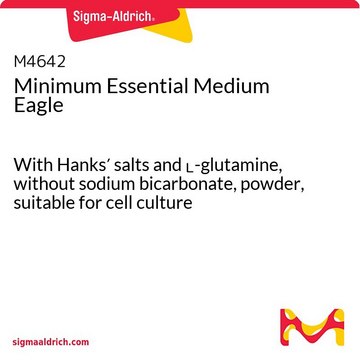M3024
Minimum Essential Medium Eagle
with Earle′s salts and non-essential amino acids, without L-glutamine, phenol red and sodium bicarbonate, Modified, powder, suitable for cell culture
Synonym(s):
EMEM, MEM
Sign Into View Organizational & Contract Pricing
All Photos(1)
About This Item
UNSPSC Code:
12352207
NACRES:
NA.75
Recommended Products
Quality Level
form
powder
technique(s)
cell culture | mammalian: suitable
components
Earle’s salts (5% CO2): yes
L-glutamine: no
HEPES: no
NaHCO3: no
sodium pyruvate: no
phenol red: no
shipped in
ambient
storage temp.
2-8°C
Looking for similar products? Visit Product Comparison Guide
General description
Minimum Essential Medium Eagle contains 19 amino acids. The essential amino acids and the non-essential amino acids: L-ala, L-asn, L-asp, L-glu, L-gly, L-pro, and L-ser. This medium is preferred for the growth of adherent cells in the presence of reduced serum or as a base for the development of a serum-free medium. It is suitable for a wide variety of cells grown in monolayers.
Application
Minimum Essential Medium Eagle has been used:
- to culture endometrial adenocarcinoma Ishikawa cells for bisphenol studies
- to culture MCF-7 cells for experimental treatments with hormone
- to maintain zebrafish pineal glands for action spectrum analysis
Features and Benefits
Contains high concentrations of amino acids so the medium resembles the protein composition of cultured mammalian cells
Quantity
Formulated to contain 9.3 grams of powder per liter of medium.
Reconstitution
Supplement with 0.292 g/L L-glutamine, 2.2 g/L sodium bicarbonate.
also commonly purchased with this product
Product No.
Description
Pricing
supplement
Storage Class Code
13 - Non Combustible Solids
WGK
WGK 1
Flash Point(F)
Not applicable
Flash Point(C)
Not applicable
Certificates of Analysis (COA)
Search for Certificates of Analysis (COA) by entering the products Lot/Batch Number. Lot and Batch Numbers can be found on a product’s label following the words ‘Lot’ or ‘Batch’.
Already Own This Product?
Find documentation for the products that you have recently purchased in the Document Library.
Customers Also Viewed
Kyle S Enger et al.
Journal of water and health, 14(6), 950-960 (2016-12-14)
Many different household water treatment (HWT) methods have been researched and promoted to mitigate the serious burden of diarrheal disease in developing countries. However, HWT methods using bromine have not been extensively evaluated. Two gravity-fed HWT devices (AquaSure™ and Waterbird™)
Anatoli Y Kabakov et al.
PloS one, 10(4), e0123718-e0123718 (2015-04-24)
During long-term potentiation (LTP) of excitatory synapses, Ca(2+)/calmodulin-dependent protein kinase II (CaMKII) is activated by Ca(2+) influx through NMDA receptors that potentiate AMPA receptor currents by insertion of additional GluR1-containing receptors at the synapse and by increasing AMPA channel conductance
Hongjie Fan et al.
Cells, 10(11) (2021-11-28)
Bisphenol A (BPA) is a well-known endocrine disruptor, widely used in various consumer products and ubiquitously found in air, water, food, dust, and sewage leachates. Recently, several countries have restricted the use of BPA and replaced them with bisphenol S
Tiefeng Cao et al.
Oncogene, 38(27), 5356-5366 (2019-05-16)
Uterine leiomyomas or fibroids (UFs) are benign tumors characterized by hyperplastic smooth muscle cells and excessive deposition of extracellular matrix (ECM). Afflicting ~80% of women, and symptomatic in 25%, UFs bring tremendous suffering and are an economic burden worldwide; they
Simona Giunta et al.
The Journal of cell biology, 190(2), 197-207 (2010-07-28)
The signaling cascade initiated in response to DNA double-strand breaks (DSBs) has been extensively investigated in interphase cells. Here, we show that mitotic cells treated with DSB-inducing agents activate a "primary" DNA damage response (DDR) comprised of early signaling events
Our team of scientists has experience in all areas of research including Life Science, Material Science, Chemical Synthesis, Chromatography, Analytical and many others.
Contact Technical Service



